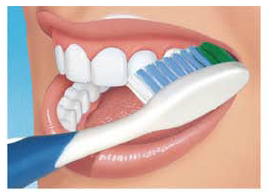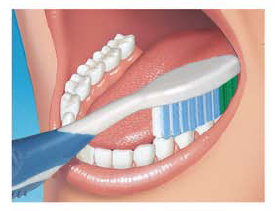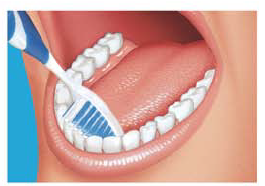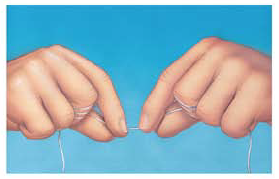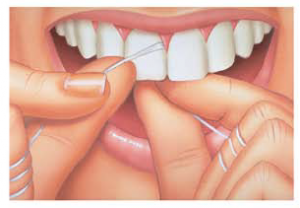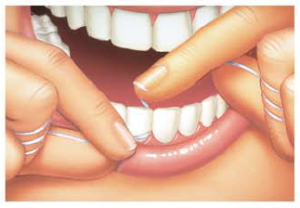Whether you’re cooking a meal or choosing a snack, choose nutritious foods for your child to promote good dental and overall health. Sugary foods can lead to tooth decay. Plaque is a sticky white film that forms on our teeth all the time. The sugars we eat and drink react with the bacteria found in plaque, which then creates an acid that destroys the enamel on our teeth. Over time, this is what creates cavities.
Some healthy suggestions when choosing snacks and drinks
- cheese and whole grain crackers
- fruit and yogourt
- vegetables and yogourt dip
- sliced hardboiled egg with whole wheat toast
- whole grain cereal and milk
- tap water
- ½ whole grain bagel and cheese
- celery and peanut butter
Brushing twice a day for 2 minutes will help you maintain a healthy and beautiful smile.
- Use fluoridated toothpaste for children over three years old.
- Use a pea-sized amount of toothpaste and always spit it out after brushing.
- Always use an appropriately sized toothbrush with soft bristles, and replace it every 3 to 6 months or after being sick.
- Hold your toothbrush at a 45° angle to your teeth. Point the bristles to where your gums and teeth meet. Use a gentle, circular, massaging motion up and down. Do not scrub your teeth back and forth.
- Clean every surface of every tooth, including the chewing surface, the cheek side, and the tongue side. Remember to brush your tongue.
- Brushing should take at least 2 minutes; try timing yourself. Brush twice a day, especially before bedtime.
Flossing cleans where the toothbrush cannot, between teeth and below the gum line.
- Cut off about 45 cm (18 in.) of floss. Wind most of it around the middle finger of one hand, the rest around the middle finger of the other, leaving about 10 cm (4 in.) in the middle.
- Hold a 2.5 cm (1 in.) section tightly and ease the floss between two teeth. Never snap the floss into the gums by pushing too hard to get the floss between the teeth.
- Be gentle and take the time needed to do a good job. You may have to pull the floss back and forth to get it through the tight spot where the teeth touch. When it reaches the gum line, curve it into a ‘C’, and slide it into the space between the gum and tooth until you feel resistance. Glide it up and down against the tooth. Unwind clean floss as you start each tooth. Remember to floss behind the last tooth.
During pregnancy, your body will go through many changes. Some of these changes can affect your oral health. The benefits of keeping your teeth and gums healthy during your pregnancy are important for both you and your baby.
Tips for healthy teeth and gums
- Brush teeth twice a day with fluoridated toothpaste. Floss daily to keep gums healthy.
- Hormone levels can change during pregnancy and cause gums to swell and bleed when brushing and flossing. This is called pregnancy gingivitis. Continue to brush and floss.
- Eat healthy and nutritious foods. During pregnancy, everything you eat, and drink becomes the main source of nourishment for your baby. Choose meals and snacks filled with enough nutrients for yourself and your baby.
If you are experiencing morning sickness, try eating dry toast or unsalted crackers. This will help settle your stomach. Morning sickness can leave stomach acids in your mouth which can damage the surface of your teeth and lead to tooth decay. If you vomit, rinse your mouth with plain water.
For more information about your oral health and pregnancy, speak to your dental provider.
Give your baby the gift of healthy teeth and gums for life, with daily brushing and nutritious meals and snacks.
- Wipe baby’s gums from birth using a clean damp cloth after every feeding.
- Start brushing your baby’s teeth twice a day after their first tooth erupts.
- Under the age of 3, you should not use fluoridated tooth paste as the chances are high that the child may swallow much of it.
- Once your child is able to spit use a smear of the fluoridated tooth paste on his or her tooth brush.
- Limit snacks and drinks that are high in sugar.
- Avoid kissing baby on the mouth and sharing utensils or cups. You may be increasing the risk of sharing cavity-causing bacteria with your child.
- Lift your child’s upper lip at least once a month to check for signs of tooth decay. These include a white chalky appearance or darker areas on teeth like the ones
As your child grows and goes through changes, so do their teeth. Baby teeth will start to fall out and adult teeth will start to come in.
- Always supervise or help your child brush their teeth up until the age of eight, or when you feel that they can do a proper job on their own.
- Make sure to use an appropriately sized soft bristle toothbrush and replace it every three to six months or after your child has been sick.
- Use a pea-sized amount of fluoridated toothpaste and brush twice a day for 2 minutes.
- Help your child learn how to use dental floss; flossing once a day, cleans between the teeth where the toothbrush cannot reach.
- Sweet and sticky snacks should be limited, and it is recommended to offer them after meals to reduce the amount of acid attacks in the mouth.
- If your child is unable to brush after eating, they can rinse with water, chew sugar-free gum or eat a piece of cheese (cheese neutralizes the acids in your mouth).
- Take your child to the dentist regularly.
- Talk to your dentist about coating the pits and grooves of your child’s molars with sealants to prevent tooth decay.
- Have your child wear a mouth guard when playing a contact sport.
Tobacco, alcohol, and drug use can cause serious health problems and can affect how your teeth look as well as the health of your mouth and gums.
Effects of smoking
- Tobacco products damage your gum tissue
- Reduced sense of smell and taste
- Bad breath, stained teeth
- Recession of the gums
- Plaque and tartar build up
- Increased sensitivity to hot and cold food or liquids
- Slower healing after dental treatment
- Increased heart rate
- Nicotine addiction
Effects of smokeless tobacco
Also known as “snuff”, “spit” or chewing tobacco, smokeless tobacco is held in the mouth between the teeth and cheek. Users spit out a black liquid that forms when the tobacco mixes with the saliva.
- Reduced sense of smell and taste
- Bad breath
- Stained teeth
- Changes in the colour and texture of mouth tissue
- Plaque and tartar build up
- Nicotine addiction
- Increased sensitivity to hot and cold food or liquids
- Recession of the gums
- Delayed healing after dental treatment
- Increased heart rate
Risk factors of using tobacco products
- Oral cancers
- Periodontal disease and tooth decay
- Mouth sores or lesions that do not heal
- Heart and lung disease
Effects of alcohol
Alcoholic drinks can contain high amounts of sugar, and some mixed drinks can contain acids which can lead to:
- Tooth decay
- Dental erosion
- Oral cancer
Effects of drug use
Alcohol and drugs such as cannabis, ecstasy, amphetamines, methamphetamines and heroin can severely effect your oral health? Here are some examples:
- Tooth loss: Severe tooth decay and gum disease can lead to tooth loss.
- Dry mouth: Many drugs affect the saliva production that occurs in your mouth which then increases your chances of gum disease and tooth decay.
- Erosion and tooth decay: Some drugs cause sugar cravings. Sugary drinks and snacks will weaken your tooth enamel and cause tooth decay. Alcohol can also contain high amounts of sugar, and some mixed drinks can contain acids. Excessive use of alcohol can cause vomiting that can lead to dental erosion. Dental erosion is the loss tooth enamel caused by acid attack.
- Teeth grinding: Some substances cause clenching or grinding of teeth. This can cause teeth to wear, crack, or chip, and can lead to headaches.
Tooth decay is the softening of the tooth enamel that could damage the structure of the tooth
Causes of cavities and tooth decay
- Poor oral hygiene: Food particles get trapped between the teeth without regular brushing or flossing. This can lead to tooth decay.
- Plaque formation: Plaque occurs when bacteria, acid, food particles and saliva combined attack the enamel of the tooth. The holes created in the tooth is a cavity.
- Eating and drinking: Sugary, sticky foods and beverages can cause tooth decay.
- Xerostomia/dry mouth: Saliva helps wash away plaque from teeth. When you have little to no saliva the plaque will build up. Some cancer treatments can also contribute to tooth decay due to poor saliva flow.
Signs and symptoms of tooth decay
- A toothache is one of the most common symptoms.
- Tooth sensitivity and pressure when biting down.
- A hole in the tooth at times is noticeable or only visible on a dental x-ray.
- An elevated area that is painful may be a sign that an abscess is present. (An abscess is a collection of pus caused by a bacterial infection.)
How to prevent tooth decay
- Daily oral hygiene, routine brushing twice a day and flossing once a day.
- Use fluoridated toothpaste.
- Limit intake of sugary, sticky foods and beverages.
- Regular professional dental cleanings and exams.
Dental injuries happen and knowing what to do when one occurs can mean the difference between saving or losing a tooth.
Toothache
- Call your dental provider, explain your symptoms and ask to be seen as soon as possible.
- If swelling is present place cold compresses on the outside of the cheek, in the area of the toothache.
- Do not place heat or medication on the sore tooth or gums.
Chipped or broken tooth
- Call you dental provider, explain your symptoms and ask to be seen as soon as possible
- If there is facial trauma, place cold compresses to the face to keep swelling down
Knocked out tooth
- Call your dental provider immediately
- Find tooth and pick it up by the crown (chewing surface) not by the root. If the tooth is dirty, gently rinse with cold water.
- Try and place the tooth back in place. If this is not possible, keep the tooth moist by placing the tooth in a container of milk and bring this to your appointment with your dentist.
Badly bitten lip or tongue
- If there is bleeding, apply direct pressure with a clean tissue or cloth.
- Place cold compresses on area if there is swelling.
- If the bleeding can’t be controlled, seek medical attention.
Jaw fractures
- Go to the emergency department immediately and prevent the jaw from moving (avoid eating and talking).
If you wear partial or complete dentures, it is very important to take care of your oral health. Be sure to keep both natural teeth and dentures clean.
Looking after your dentures
- Clean them every day using a denture brush or soft toothbrush after each meal and before bed. Plaque and tartar can build up on false teeth, just like they do on natural teeth.
- Remove dentures at night and soak them in warm water and a denture cleaner overnight. This also gives your gums a rest.
- After soaking overnight, rinse and brush the dentures prior to wearing them for the day.
- Brush both the denture and your gums carefully using a soft toothbrush. Be sure to massage your gums. Use a separate brush for cleaning any natural teeth.
- Clean cheek, tongue and roof of the mouth with a soft toothbrush at least once a day.
- Regularly check dentures for proper fit. Full or partial dentures that are loose can prevent proper chewing and irritation of the gums.
- Regularly check dentures for cracked or broken teeth.
What not to do to your dentures
- Do not soak or rinse dentures in hot water. This can change the shape or fit of the dentures.
- Do not use cleaners that can scratch and remove the surface of the dentures.
- Do not use bleach to clean or soak dentures as it could discolour and weaken the denture structure.
- Do not scratch dentures with sharp instruments attempting to remove hard deposits. These hard deposits should be removed by a dental professional.
Gingivitis means inflammation of the gums. The most common causes of gingivitis is the accumulation of plaque between and around the teeth.
Signs and symptoms (H3)
- Bright red or purple gums
- Tender gums that may be painful to the touch
- Bleeding from gums when brushing and flossing
- Bad breath
- Inflammation or swollen gums
Gingivitis often resolves with good oral hygiene, such as brushing at least twice a day and flossing once a day. When plaque is not removed adequately, it can harden into calculus or also known as tartar. Calculus is yellow in colour and can only be removed by a dental professional. Regular dental visits are important in order to keep your teeth healthy.
Periodontal disease is a serious gum infection that damages the gums and destroys the bone that supports your teeth. This can lead to tooth loss and other serious health complications.
Signs and symptoms
- Bright red, dusky red or purplish gums
- Swollen or puffy gums
- Gums that feel tender when touched
- Gums that bleed easily
- Gums that pull away from your teeth, making your teeth look longer than normal
- New spaces developing between your teeth
- Pus between your teeth and gums
- Bad breath
- Loose teeth
- Pain when chewing
The best way to prevent periodontal disease is to follow good oral hygiene.
- Brushing your teeth for 2 minutes twice a day and flossing at least once a day.
- Regular dental visits
Oral cancer refers to all cancers of the oral cavity, which includes the tongue, lips, throat, tonsils, gums, lining inside the lips and cheeks, roof of the mouth and floor of the mouth. If not treated early these issues can lead to further complications.
Signs and symptoms
- Lesions on lips or in mouth (that don’t heal in 7 to 10 days) or unusual bleeding
- Lumps or patches in mouth or cheek
- Problems swallowing/sore throat
- Numbness/tenderness in mouth or face
- General pain or swelling in head-neck area
- Slurred or changes in speech
- Losing teeth/bad breath
- Weight loss
- Difficulty or pain when chewing or swallowing
- A change in the voice and/or pain in the ear
Risk factors
- Tobacco and cannabis consumption (cigarettes, pipes, cigars, smokeless tobacco [chewing tobacco])
- Alcohol consumption
- Human Papillomavirus Virus infections
- Exposure to sun
Your dentist does more than protect and care for your teeth, gums and smile. Your dentist can also help keep you healthy. As oral health experts, dentists are in a unique position to help in the early detection of many medical conditions including cancer. They are trained in medicine, so they recognize the relationships between oral and overall health.
It is important to remember that your dentist is your oral health expert. They have the training and experience necessary to properly assess your oral health.
Teamwork involving self-care and professional care from your dentist will be beneficial in keeping your healthy smile and slow the progression of diabetes.
The most common oral health problems found in people with diabetes
- Gum disease
- Tooth decay
- Dry mouth, also known as xerostomia
- Fungal infections
- Lesions (sores) in the mouth
- Taste impairment
- Infection and delayed healing
The mild form of gum disease is called gingivitis, in which the gums become sore, red, bleeding or puffy. Untreated, gingivitis can escalate to periodontitis. Research shows that there are more occurrences of gum disease among people with diabetes and pre-diabetes. Gum disease, heart disease, stoke and kidney disease are all serious medical conditions associated with diabetes.
Xerostomia refers to the dryness of the mouth due to lack of saliva.
Causes
- Age (more prevalent in aging populations)
- Some medications (side effect)
- Cancer treatment
- Injury or surgery
- Tobacco
- Dehydration
- Some health conditions (anxiety, depression, snoring, sleeping with mouth open, poorly controlled diabetes)
Signs and symptoms
- Bad breath
- Dry, cracking or splitting of lips
- Inflammation of the inner lining of the cheeks, lips, tongue and mouth ulcers
- Snoring/sleeping with mouth open
- Fungal infection in the mouth (thrush)
- Problems swallowing and chewing
- Increase in plaque and tooth decay
Treatment
- Sipping non-carbonated, sugar-free fluids
- Chewing gum that contains xylitol
- Using saliva substitutes
- Not wear dentures during sleep
Avoid
- Mouthwashes that contain alcohol
- Chewing or smoking tobacco
- Sugary foods or drinks
- Acidic foods or drinks
- Dry/spicy foods
- Alcohol consumption should be kept to a minimum or avoided
Oral piercing has become a popular form of self-expression. Be aware of the risks associated with mouth jewellery such as, infections and diseases; allergic reactions; chocking; injury to gums and chipped teeth.
Oral injuries, such as broken or damaged teeth, or a dislocated or broken jaw are all injuries that can be prevented by wearing a mouthguard. A mouthguard should be worn when playing any contact sports involving possible falls and objects that come into contact with your face. A mouth guard can be made professionally by a dentist to help protect your teeth and jaw by acting as a cushion or shock absorber.
You can get a sexually transmitted infection (STI) by participating in oral sex. Learn more about reducing your risks of developing an STI.

